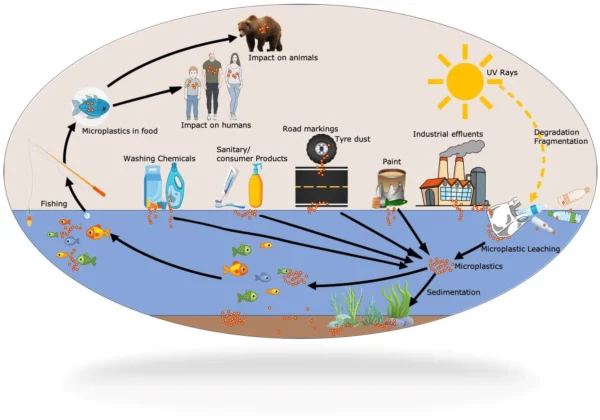In recent years, microplastics and nanoplastics have become an increasing concern for human health. They enter the body through various pathways, particularly through inhalation and food consumption. While there is no definitive conclusion about their specific impacts on health, recent studies suggest that the accumulation of microplastics in organs like the brain could lead to serious issues, including neurodegenerative diseases like dementia. So how do microplastics actually enter the body, and how are they affecting human health?
Microplastics are plastic particles smaller than 5mm, typically formed from the breakdown of larger plastic products in the environment. Global plastic production now exceeds 300 million tons per year, with approximately 2.5 million tons of plastic currently floating in the oceans. This means that the level of plastic pollution in the environment is increasing, leading to the infiltration of microplastic particles into the air, water sources, and food. These plastic particles are so small that they are hard to detect with the naked eye, but they can be inhaled when we breathe in polluted environments or ingested through food and drinks.

A study published in the journal Nature Medicine in 2024 showed that microplastics and nanoplastics accumulate the most in the brain, far exceeding accumulation in other organs like the liver and kidneys. According to this research, brain samples taken from individuals with dementia showed significantly higher plastic accumulation compared to samples collected in 2016. Although the study did not confirm that microplastics cause dementia, their accumulation in the brain and other organs raises concerns about the long-term effects on human health.
One key reason microplastics easily enter the body is their ability to be absorbed through the respiratory system. When we breathe in air containing plastic dust, these tiny particles pass through the nose and into the lungs, where they may then travel to other organs. Studies have shown that the presence of plastic particles in the body can cause inflammatory reactions, tissue damage, and impair cell function. While the long-term effects of exposure to microplastics have not been fully studied, concerns about their impact on brain health and the nervous system are very real.
One notable point from the study is the significant increase in microplastic levels in the body over time. Samples from 2024 showed much higher concentrations of microplastics in the brain compared to those collected in 2016, especially in individuals with dementia. This not only points to a rise in environmental pollution but also raises questions about the potential effects of prolonged exposure to microplastics.
“We believe this simply reflects the accumulation of plastic in the environment and the increasing level of human exposure to these small plastic particles.” – Matthew Campen, Professor of Pharmaceutical Sciences, University of New Mexico, 2024.
This increase has led scientists to question whether there is a link between microplastics and neurodegenerative diseases like dementia. Experts recommend that more research is needed to determine the long-term effects of microplastic exposure on human health, particularly for vulnerable populations such as the elderly or those with existing neurological issues.
So what can we do to reduce the risk of exposure to microplastics and protect our health? Experts suggest several practical measures to limit plastic exposure in our daily living environment. First, we should reduce the use of single-use plastic products, opting instead for reusable items or materials that are safer. Limiting the consumption of plastic-packaged food and drinking water from controlled sources can also help avoid water contaminated with plastic particles.
Additionally, for those living in areas with high pollution risks, using air purifiers at home can be an effective solution to reduce microplastics in the air. For people living near industrial zones or areas with high pollution levels, wearing masks and maintaining good personal hygiene are simple but effective measures.

The information above shows that we live in a world where microplastics are increasingly unavoidable. However, by proactively understanding their infiltration and impact, we can take appropriate preventative measures to protect our personal health and the health of the community.


HPX24h > Health > Exploring How Microplastics Enter the Body and Affect Health
Tagged Articles
Gold in the Human Body: A Scientific Look at the ‘Hidden Gold’ Inside You
Your Body Is Not the Same as It Was 10 Minutes Ago: The Continuous Regeneration Process of the Human Body
What Is Nutrition? Why Is It Important For Health?
Top Reads from This Category
Health
E. Coli In The Gut May Trigger A ‘Chain Reaction’ Leading To Parkinson’s Disease
Health
Natural Remedies for Stomach Pain Every Parent Should Know
Health
Playing with Dirt: The Surprising Secret to Children’s Health and Immune System
Health
Fruits That Can Spike Blood Sugar Levels: Be Cautious
Health
Natural Remedies for Relieving Constipation: Small Changes, Big Results – No Medication Needed
Health
The Mystery of Newborn Weight: How Does It Progress Each Month?
Health
Forgetfulness Can Bring Unexpected Evolutionary Benefits
Discover New Topics
Science
Stem Cell Therapy for Lung Cancer: A New Hope Entering Human Trials
Healthy Eating
Why Is Nutrition Research So Complex?
Fitness
More Flexible – The Secret to Longevity?
Animals
Rats Help Each Other: When Compassion Emerges from Small Creatures
Science
New Hope for the Blind: A Breakthrough in Retinal Implant Technology
Health
What Does a Right-Side Headache Indicate About Your Health?
Healthy Eating
5 Serious Consequences of Eating Too Much Sugar That You Didn’t Expect
Science
Extinct Black Rhinos Could Make a Comeback with Genetic Technology
Health
5 Tips to Help You Overcome Smartphone Addiction
Healthy Eating
How to Create a Diet that Reduces Disease Risk While Still Being Delicious?
Animals
The Secret Behind Turtle Eggs Hatching at the Same Time: A Fascinating Reason
Fitness
Walking or Running: Which Is Better for Health and Weight Loss?
Health
How Losing Just 5% of Your Weight Can Reduce the Risk of Diabetes